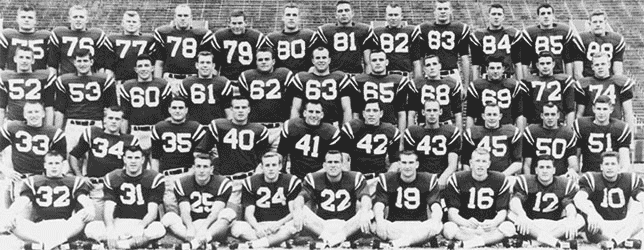Did You Know? First College Replay
 Nick Saban

Josh Booty
|
Scott Rabalais says it may have been the first "instant replay" in college football history.
The date was November 4, 2000. Nick Saban's first Tiger team was trying to end the Alabama jinx in Baton Rouge. LSU had last beaten the Tide at home in 1969.
The play in question occurred with LSU leading 23-21 with 7:06 left in Q4. Alabama punted. As Dominick Davis prepared to catch the ball, Shontua Ray belted him. The ball squirted to the LSU 14 where the Tigers' Erin Damond recovered. The officials then conferred to determine whether Ray had interfered with Davis. After picking up the flag, the referee indicated Alabama's ball! However, the Tigers on the field pointed to the video replay in the EZ, which showed clearly that Damond had recovered. DB Fred Booker saw one official peek at the big screen. Michael Bonnette, LSU Sports Information Director, told electronic media coordinator Kevin Wagner to keep replaying the footage showing the Tiger recovery. Finally, the officials corrected their error and gave LSU possession.
QB Josh Booty soon threw a 50y pass to TE Robert Royal that led to a 16y TD to Royal. LSU held on 30-28.
Afterwards, SS Lionel Thomas said, "The last time we beat them here, man walked on the moon. We'll be able to tell our kids we were part of history." Saban opined: "The player of the game is the JumboTron operator." He awarded Wagner a game ball.
Reference: The Fighting Tigers 1993-2008, Scott Rabalais
|
 Dominick Davis

Robert Royal
|
Memorable Game: Tulane 1949 – I
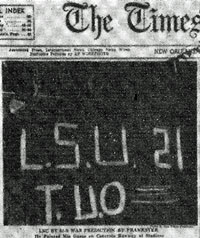

Gaynell Tinsley
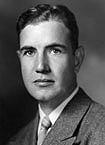
Ed McKeever
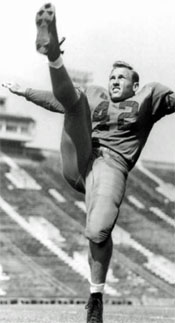
Kenny Konz
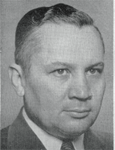
Henry Frnka
|
Fans arriving at Sugar Bowl Stadium on November 26, 1949, for the annual season-ending clash between Tulane and LSU saw with their own eyes what the Times-Picayune had described in an article: " L-S-U" burned into the field between the 30-yard lines. Those entering the south stands also saw what the TP had shown in a front page picture: LSU 21, TU 0 painted on a runway.
As was typical in those days, "visitors" from each school left a mark on the rival's campus.
- Two weeks before the big game, Tulane partisans dropped in on the LSU campus and left green calling cards on speed limit signs on streets near the university. These bore the score of the 1948 game, "Tulane 46 LSU 0."
- The Saturday before the game, vandals from LSU etched "LSU 21 Tulane 0" in rock salt letters 20' wide in the center of the Tulane Stadium playing field. They also daubed similar sentiments in green paint on the administration building, the football players' dormitory, the stadium runway, the campus sidewalks, and a dormitory at Newcomb women's college. This would prove to be one of the greatest prognostications in football history.
This renewal of the annual rivalry that began in 1893 was especially significant to the LSU team and fans.
- The previous year the Green Wave had romped 46-0 in Baton Rouge in the most lopsided outcome in the series to that point.
- Underscoring the importance head coach Gaynell Tinsley placed on this game, the previous week he had pulled his starters during Q3 of a 48-7 rout of Southeastern Louisiana and sent the first and second string to the practice field outside Tiger Stadium to start implementing the Tulane game plan.
- Tinsley had assistant Ed McKeever, a disciple of Notre Dame's Frank Leahy, give motivational talks to the team.
- "He started out softly, then built up. At the end, he was screaming," remembered G Charles Cusimano, later a long-time member of LSU's Board of Supervisors.
- McKeever saved his best for the minutes right before kickoff. S Kenny Konz recalled, "The most amazing thing of that day was that nobody was hurt as we all hit the door trying to get out on that field."
Tulane had its strongest team since the 1931 Rose Bowl squad.
- Henry Frnka's squad had been ranked #1 in the preseason by The Sporting News and was in everybody's top 10.
- However, a 46-7 disaster at South Bend eliminated the Greenies from national championship consideration.
- Nevertheless, TU had already clinched the SEC championship with a 5-0 record and, at 7-1-1 overall (including a 21-21 tie with Navy), had returned to the AP Top Ten.
- The Sugar Bowl, although not obligated at that time to select the SEC champion, was poised to invite the hometown Greenies after they disposed of the Tigers.
LSU had rebounded nicely from the 3-7 debacle of 1948, its worst season since 1922.
- After starting 2-2, the '49 Tigers had won five in a row.
- They had already beaten two conference champions, Rice of the Southwest Conference (14-7) and North Carolina of the Southern (13-7).
- LSU had completely turned the tables on four opponents from 1948.
- North Carolina 7-34 (1948) to 13-7 (1949)
- Ole Miss 19-49 to 34-7
- Vanderbilt 7-48 to 33-13
- Mississippi State 0-7 to 34-7
- Could the Tigers get the same revenge against their archrival?
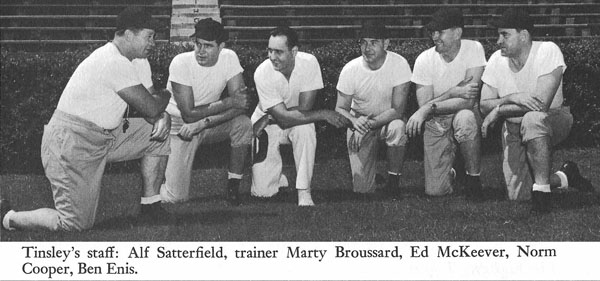
Continue below ...
|
Memorable Game: Tulane 1949 – II
The week of the Tulane game, LSU coach Gaynell Tinsley pinned his hopes on jack-of-all-trades S Kenny Konz.
- The 5'10 185 lb junior had played S, CB, QB, FB, and E.
- He kicked off, kicked extra points, punted, and returned punts.
- Konz had played only six-man football at small Weimar (TX) High School. Nevertheless, his speed (9.9 for the 100y dash) had caught the eye of many college recruiters, including a Tiger fan named Rubin Moss, who enthusiastically recommended Kenny to the LSU coaching staff led by Bernie Moore.
- Konz had decided he wanted to attend an out-of-state school. I wanted to go someplace where I was really away from home – but not so far that I couldn't get back quickly if my family needed me. LSU fit the bill.
- Moore thought long and hard before giving a scholarship to someone who had never played the same game he coached. He finally decided to take a chance.
Konz wasted little time in living up to Tinsley's expectations.
- Tulane received the opening kickoff on a clear cool afternoon before 79,292, the largest crowd ever to see a regular season game in the Southeast or Southwest at that time. 200 police and security guards had been employed to keep the peace. (The crowd included an eight-year-old boy's father and older brother as he listened on the radio at home.)
- The Greenies started out like a Top Ten team. All-American FB Eddie Price gained 20, then 15 to put the ball in LSU territory. However, Tulane jumped offside, then lost five more yards in three plays and had to punt.
- Konz caught the ball on the run at the LSU 8 at the south end of the field (where the 21-0 prediction had been painted). He turned upfield and raced untouched to the EZ. "I didn't see a single Tulane man on his feet. ... Everyone near me was knocked down. Fact is, some of our guys blocked two men." Breaking into the clear at midfield, Konz had only one man to beat – Price. He did so easily.
The sudden turn of events seemed to rattle the Green Wave.
- There was no more scoring the first half as neither O could move the ball.
- Finally, in Q3, the home team reached the LSU 12. Then the Tiger D pushed the Wave back and took over on the 35.
- On the first play, sophomore HB Lee Hedges bolted 65y for a TD to make it 14-0. All I had to do was run like hell, Lee said afterward.
In the last quarter, the Tiger O generated its first sustained drive of the game.
- Starting on its own 45, LSU took ten plays to reach the EZ.
- With the ball on the 1' line, slick QB Charlie Pevey faked to FB Zollie Toth up the middle and handed the ball to HB Billy Baggett, who circled end untouched for the TD.
- The PAT made the final score 21-0, exactly as the vandals' signs predicted!
- From 0-46 to 21-0 in one year - a 67-point turnaround!
Konz had a great game in addition to his electrifying punt return.

1949 Tigers (L-R): Wren Worley, Dale Gray, Jim Lyle, Ray Bullock, Melvin "Sam" Lyle Tinsley recalled: A coach can never really tell when a ball club is ready, but the best medicine so far as I was concerned was that bus ride to New Orleans. It gets a team to thinking. Two hours is just long enough. The ride in 1949 was silent, and I could feel that the boys, win or lose, would give a good account of themselves. I think they realized if they didn't, Tulane was good enough to run them out of the stadium. So we had a little fear going for us too. The one fear of a team being keyed up is a bad break. The higher you are, the more you are deflated if something doesn't go right for you early in the game. On the other hand, a good break will send you through the roof.
No team I've ever seen played as close to 100 percent of its capabilities as this 1949 bunch did against Tulane. On every tackle, it seemed like we had four men or more around the ball. Konz played the greatest game at safety I ever witnessed.
The SEC had a rule requiring a team to have a .750 winning percentage in conference games to participate in a bowl game.
- At 4-2 because of early losses to Kentucky and Georgia, LSU was only .667.
- However, the conference quickly amended the rule to allow the Tigers to accept the Sugar Bowl invitation that had been reserved for the Green Wave.
- This proved to be a mixed blessing as Bud Wilkinson's Oklahoma powerhouse clobbered the Cinderella Tigers 35-0. (The eight-year-old boy watched that one on a small black-and-white TV with his family at a barroom in uptown New Orleans.)
Kenny Konz made all-SEC as a senior and was drafted in the first round by the Cleveland Browns.
|
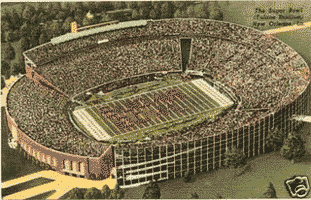
Tulane Stadium

Eddie Price
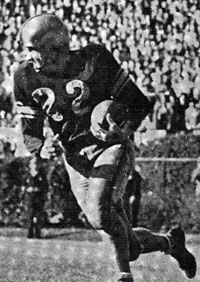
Kenny Konz sets out on
his punt return TD.

Lee Hedges
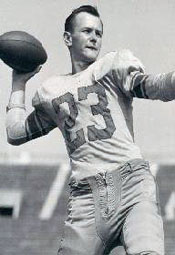
Charlie Pevey
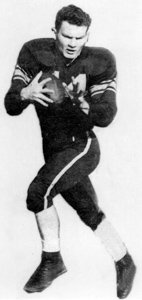
Billy Baggett
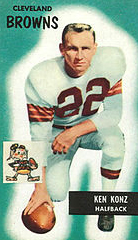
Top of Page |
OT Robert Dugas was recruited by the University of Nebraska when he was a senior at Hahnville High. However, the "cradle Tiger" signed with Charlie McClendon's Bengals. Little did Dugas know at the time that Nebraska football would continue to play a role in his life.
Two years later, Dugas played against the preseason #1 Cornhuskers in Tiger Stadium in the opener of his sophomore season in 1976. That game is remembered for Mike Conway's 44yd FG attempt that slid wide by inches at the final horn to leave the final score 6-6.
Robert played in the 1977 Sun Bowl (a 24-24 loss to Stanford) and the 1978 Liberty Bowl (another loss, 20-15 to Missouri). He made All SEC three-times and All-American and Academic All-American. He received an NCAA Top Five Student-Athlete Award in 1979 and the National Football Foundation and Hall of Fame Scholar Athlete Award. He was inducted into the LSU Athletics Hall of Fame in 1990.
After completing a degree in zoology at LSU, Dugas went to LSU Medical School. He completed his M.D. in 1983 with a specialty in orthopedics. He then received a one-year fellowship in sports medicine at the University of Wisconsin.
In 1990, he joined Nebraska Orthopaedics and Sports Medicine in Lincoln as a practicing surgeon. In that capacity, he was Nebraska's team physician for the next 16 years.
In 2007, Bob and his family moved to Baton Rouge to join the Bone and Joint Clinic there. One of his children, Richard, is a redshirt sophomore Tiger gridder.
Reference: LSU Alumni Magazine, Spring 2009
|


Dr. Robert Dugas
|
Memorable Game: First Big Ten Opponent
 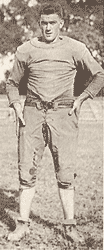
Coach Mike Donahue QB Opie Dimmick
Indian
The GridGraph from the 1920s
Costing $1,000, the device was run by operators behind the 15'x12' board who turned on bulbs
to represent the type of play, the offensive players involved, and the tackler(s).
Another operator moved a light bulb to indicate the progress of the ball down the field.
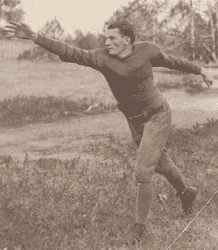 Norman Stevens |
On October 11, 1924, LSU played its first game against a school from the Western Conference (forerunner of the Big Ten). Mike Donahue's Tigers traveled 24 hours by train to Indianapolis to play the Indiana Hoosiers.
Because LSU was an unknown commodity in the Midwest, Indiana sent a publicist to Baton Rouge to send back stories about the Tigers to increase attendance.
- Donahue had sent an assistant (perhaps a young man named Tad Gormley) to scout the Hoosiers in their 21-0 victory over DePauw the week before.
- Donahue's second LSU squad since coming from Auburn was 2-0 after victories over Spring Hill 7-6 and Southwestern Louisiana Institute (today's ULL) 31-7.
The day of the game was proclaimed "Dixie Day" in Indy, and a crowd of 12,000 filled the baseball field stands.
- Almost all were Hoosier faithful except for the LSU Cadet Band that had traveled with the team.
- Back home, Tiger rooters gathered at State Field (precursor of Tiger Stadium) to follow the action by wireless on the GridGraph mounted on a stage and narrated by "Wild Bill" Graham.
The game was summarized by one newspaper service out of Chicago like this.
A tornado came out of Louisiana and swept Indiana University off its feet. Louisiana beat the Hoosier squad, 20 to 14. Both teams showed powerful offensive strength but Indiana's was the weaker. Indiana put the ball on Louisiana's 2-yard line in the last minute of play but failed to score.
The Western Conference team got on the scoreboard first.
- Indiana scored quickly when LSU QB (and future judge and LSU Board member) Oliver "Ike" Carriere fumbled a punt, and a Hoosier ran 40y to pay dirt.
- The visitors retaliated with a 60y drive that ended with a 15y run by FB Allen Connell, a transfer from Vanderbilt.
- Indiana wasted little time in scoring again on a long TD run to make it 14-6 at the break.

Norman Stevens running for TD against Indiana 1924 |
In Q3, Carriere made amends for his earlier bobble by recovering a fumble on the Hoosier 42.
- Two plays later, Norman Stevens burst 38y to pull LSU within one as hats flew and cheers erupted 850 miles away in Baton Rouge.
- More exultation back home when LSU methodically drove 67y in Q4 to score on a short run by Gus Jackson for a 20-14 lead.
- However, IU roared back, reaching third-and-goal on the 2. But the defense held on two runs, Ben Miller breaking through on fourth down to nail the ball carrier on the 5.
- Then Carriere asked Miller to punt the ball out of danger. He booted his first collegiate punt to midfield and then made the tackle just before time ran out.
The victory removed the goat horns from QB Opie Dimmick. In Q3, upon intercepting a pass, he paused to yell to the stands "Bound for Dixie!" The delay allowed him to be overtaken on the IU six and cost LSU a touchdown.
Reference: The Fighting Tigers II, LSU Football 1893-1980, by Peter Finney
Michael "Mikie" Mahtook from Lafayette played LB at LSU from 1979-82, lettering in 1982.
- His brother Robbie also played LB for the Bengals, lettering in 1979-80.
- Another brother, Ronnie, played DL at USL in 1980-1.
Tragically, Mikie Mahtook died suddenly of cardiomyopathy, a heart muscle disease, at age 32.
- His widow Mary was left to raise their 4-year-old son, Michael Jr., and two-year-old twin daughters.
- The uncles helped her raise the children.
Little Mikie grew up to be a two-sport star at St. Thomas More HS in Lafayette.
- The school was formed by the merger of Cathedral-Carmel, the alma mater of Mikie's father and uncles, and Fatima.
- Mahtook helped the Cougars win three baseball district titles and two football district titles. He made All-State as both a QB and a CF.
- Several schools (ULL, Louisiana Tech, Houston, and Connecticut) offered him the opportunity to play both sports.
- However, he wanted "to just play one sport and focus on it and try to get as good as you possibly can get at it." And he "wanted to play where his dad played."
- So he signed a baseball grant-in-aid with LSU and started in the OF for three seasons. "As a little kid, I always dreamed about getting the game-winning hit for LSU, not throwing the game-winning TD."
Reference: "The Son Rises," Glenn Guilbeau, theadvertiser.com
|
|
Memorable Game: Tulane 1965 – Was It Something We Said?
Cotton Bowl-Bound Tigers Eradicate Hapless Green Wave in Stunner, 62 to 0
That was the Times Picayune headline the day after LSU's third 62-0 thrashing of TU in the first night game ever played in the series. Both teams had endured disappointing seasons.
- Tulane came into the annual finale 2-7 in Tommy O'Boyle's fourth (and last) season at the helm, the school's ninth straight losing season on the gridiron. This would be the Greenies' last SEC game since the school had announced its withdrawal from the conference to become an independent.
- Charlie McClendon's Bayou Bengals were 6-3 and under consideration by the Cotton Bowl. However, much more had been expected of this squad. Some of the blame lay with injuries, particularly to sophomore QB Nelson Stokley, who had made a splash running the option O until a knee injury in the Ole Miss game ended his season.
Still, no one expected the explosion that detonated on the Tiger Stadium turf that night.
- LSU scored less than three minutes into the game following an INT by Mike Vincent. By the end of Q1, the count had reached 28-0. Wave QB Bobby Duhon, future RB with the New York Giants, had already thrown three picks.
- Pat Screen enjoyed his best game in his last contest in Tiger Stadium. Himself a victim of a shoulder injury that ended his sophomore year prematurely, he threw two TDs to WB Billy Masters and ran for another score.
- The Tigers led 34-0 at the half and 48-0 after Q3, with Sam Grezaffi's 78y punt return the electrifying moment in that stanza.
- Jim Dousay's 4y TD made it 54-0. Then the PAT tandem of Billy "Captain Easy" Ezell and Doug Moreau implemented a plan they had hatched for three years and switched places. Moreau held, and Ezell kicked. But the try failed.
Moreau: This was a long-time-in-coming plan, because Billy was the holder for the three years that I kicked. We’d always planned that when we had the opportunity, he would get to try a kick. So the last game of our senior season was against Tulane ... As the game went on, we're up there in the 30s, there was no question that we could score whenever we wanted. So the way the numbers were working out, we had 48 and figured out what we had to do [to win 62-0]. We had to score twice, and we wanted to exactly match the 62. And Tulane wasn't happy, because we were scoring pretty easily. So we’re at 48 and we score, [but] we don’t know if we’re going to have enough time to score again, so this was the time, because Billy was waiting three years to try the extra point. ... So we line up, I'm holding, Billy's kicking and there you go. But he missed! That's not what we expected and that's not what he was supposed to do. [But] what then happened is we got the ball back and we scored again. But because he had missed the extra point the last time, we went for two. Leading 60 to nothing. That really pissed them off.
- When Don Schwab scored from the 1 to make it 60-0, the crowd chanted for 62.
I know because I was in the LSU Student Section chanting also. If TU, whom I had rooted for in high school, was going to put that pitiful a team on the field, then pour it on. So LSU went for two. On the first try, the DB simply grabbed Moreau as he made an out cut. The pass sailed incomplete as the penalty flag flew in. On the second try, the DB just stood and watched Moreau, and the magic 62 was attained.
Afterward, Screen explained why the Tigers had rubbed it in.
We've been waiting for this game for a year. They cut us pretty deep with some of their remarks after last season's game [a 13-3 Tiger victory]. ... Stuff like, Mac's boys better start getting ready for us. Well, the coaches didn't let us forget. They had all those stories from last year up on the bulletin board this week.
Personal aside: I played on a baseball team with Pat Screen in the 12-year-old NORD summer league at City Park. He was our SS and best player even though he was only 10! Pat grew early and reached his maximum height (5'10") by eighth grade. He earned three letters each in football, basketball, baseball, and track at Jesuit. Sadly, his life ended tragically.
Reference: Tales from the LSU Tigers Sideline: A Collection of the Greatest Tigers Stories Ever Told, Lee Feinswog (2002)
|
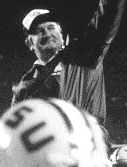
Charlie McClendon
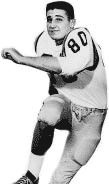
Doug Moreau

Sammy Grezaffi

Don Schwab

Pat Screen as mayor of Baton Rouge
|
Weightlifting is part of every football program today from high school (if not earlier) to the NFL. Did you know that a Baton Rougean who attended LSU was one of the pioneers in weight training for athletes and football players in particular? And that he made an unsung but important contribution to an LSU national championship and to an American Football League championship team?
- Born in Baton Rouge in 1920, Alvin Roy graduated from Istrouma High School and attended LSU until he joined the Army during World War II.
- In the military, he met Bob Hoffman, called the "godfather of barbells in the U.S." who was assistant U.S. Olympic weightlifting coach in the 1948 and 1952 Olympics and head coach in 1956 and 1960.
- While stationed in Paris, Roy learned the latest training techniques.
- After his army service ended, he was selected by Hoffman as manager/trainer of the 1952 U.S. Olympics weightlifting squad.
In 1948, Roy returned to BR and opened Alvin Roy's Health and Strength Studio, Louisiana's first "commercial gym" and one of the first of its kind in the entire country.
- The Studio offered saunas, steam rooms, and message therapy as well as "resistance training" using free weights since machine weights had not yet been invented.
- Alvin worked hard to overcome the prevalent belief among coaches of many sports that weight training made athletes slow and uncoordinated by destroying muscle elasticity.
Roy's first football clients came from the high school ranks.
- The day after Baton Rouge High walloped Istrouma in 1953 behind Roy protege Jim Taylor, Indians coach "Fuzzy" Brown decided to institute a weight training program. So he sent his players to Roy.
- A 168-pound sophomore RB named Billy Cannon particularly benefitted. By the time Billy entered LSU two years later, he was up to 193. By his sophomore year when he began varsity play, he weighed 200 and pressed 270, which was only 12 pounds off the Olympic record at the time.
- LSU coach Paul Dietzel was so impressed that he sent his players to Alvin's studio since LSU had no weight room of its own.
- Roy never asked for compensation from the university. What he created is considered the first weight training program at any university and contributed greatly to the Tigers' 1958 National Championship success.
- Roy eventually opened 27 gyms around the country.
Word of Alvin's work caught the attention of Sid Gillman of the San Diego Chargers.
- He hired Roy in 1963 to establish the first comprehensive year-round program for a pro football team.
- Alvin thus became the first person to have the title of Strength Coach.
- Initially, members of the Chargers squad, including black players, came to Baton Rouge to benefit from Roy's resistance training.
- San Diego won the AFL championship in 1963 thanks in part to Alvin's contributions. He collaborated with Gillman on a 1964 book, World Champion San Diego Chargers Strength Program.
Roy later helped the Kansas City Chiefs win the Super Bowl in 1970.
- Then the Dallas Cowboys hired him and won the championship in 1972.
- In 1979, he joined the Oakland Raiders but died of a heart attack that year at age 59.
Unfortunately, many players, including members of the '63 Chargers, have accused Alvin of giving them steroids as part of his program.
- Roy learned about Dianabol at the 1960 Olympics when the hyped Russians creamed the "clean" U.S. weightlifting team.
- Ignorant of the drug's side effects, Roy considered himself on the cutting edge of weight and strength gain at that time.
- Steve Courson, who played for the Steelers from 1978-83, has claimed that his heart trouble was a result of steroids he obtained from Roy, whom he called "the father of the steroid in the NFL."
- Joe Don Looney, a star RB for Oklahoma who also played in the NFL, wrote in his autobiography that he came to BR to train with Roy and get steroids.
- Gayle Hatch, Roy's protegé who ran his BR Studio after a group of businessmen bought it in 1978 and became an Olympic trainer himself, says: "That's a black mark, I guess, on his legacy."
Alvin Roy's impact continues at LSU to the present.
- One of Hatch's former pupils is Tommy Moffitt, the Tigers' current strength coach.
- LSU gives the annual Alvin Roy Strength Training Award to the football players who show year-round dedication to strength and fitness.
|
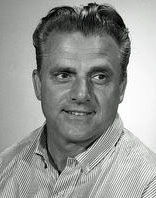
Alvin Roy

Jimmy Taylor
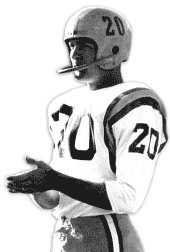
Billy Cannon
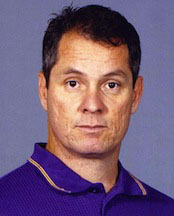
Tommy Moffitt
|
References: "Powerful Impact," Lee Feinswog, 225batonrouge.com; ESPN: Pumped Up Pioneers: the 1963 Chargers
Memorable Game: Ole Miss 1959 – Run, Billy, Run!

Tiger Stadium 1954-1977
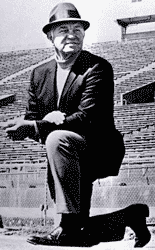
Johnny Vaught
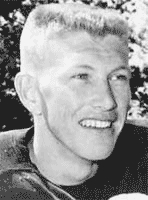
Billy Brewer
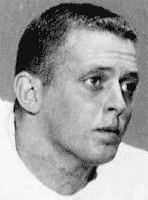
Bob Khayat>
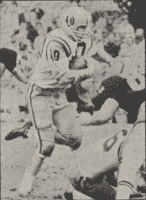
Earl Gros
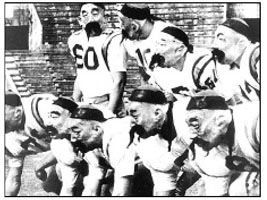
The Chinese Bandits
|
Inexplicably, LSU scheduled its 1959 homecoming game on Halloween against Ole Miss, the very opposite of a patsy.
- The two old rivals had played an epic contest the year before in Tiger Stadium, with the Tigers, #3 in the AP poll, defeating the Rebels, who were #6, 14-0 thanks in part to two goal line stands at the South end of the stadium.
- Now, a year later, LSU, as defending national champions, had been #1 all season and sported an 18-game winning streak.
- The visitors, also 6-0, ranked #3.
Rain earlier in the day made the field wet and contributed to the conservative approach of the two defense-minded coaches, Paul Dietzel and Johnny Vaught.
- Coaches in that era were also limited by the substitution rules, which decreed that a player who started a quarter could leave and return once in that period while a replaced player who did not start the quarter could not return until the next quarter.
- A change prior to the 1959 season allowed one player per side to enter when the clock was stopped. Dietzel would use that rule advantageously in Q4.
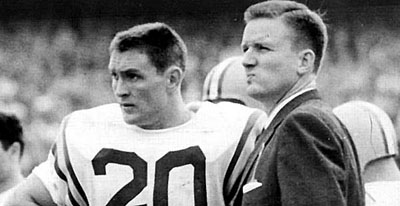
Billy Cannon and Paul Dietzel A packed house of 67,000 saw LSU start in a charitable mood, giving Ole Miss five scoring chances in the first half, one of which resulted in points.
- LSU took the opening kickoff and moved smartly to the Rebel 40 where Donnie Daye fumbled and Billy Brewer, later the Rebels' head coach (1983-1993), made the first of his three recoveries.
- Senior QB Bobby Franklin set up the first Ole Miss threat when he punted 43y out of bounds on the 5. LSU's star HB Billy Cannon ran to the 21 where Brewer pounced on his second fumble.
- Ole Miss ran the ball to the 3 where, on fourth down, Bob Khayat booted a FG for a 3-0 lead. (Khayat became Chancellor of Ole Miss in 1995.)
- After a poor punt, the Rebels reached the Tiger 30 but stalled. Then in Q2 LSU C Johnny Langan batted down a Rebel fourth down pass at the 22. A few minutes later, the Rebs were back at the 22, but LSU stopped a series of passes to take the ball back.
- On the last play of the half, Vaught disdained a FG from the LSU 7, but Franklin's rollout was stopped short of paydirt.
Dietzel's determined gang spent most of Q3 in Ole Miss territory.
- A drive to the 31 after a Cannon INT of Jack Gibbs resulted in a missed FG by Wendell Harris.
- A short time later, the Go Team, Dietzel's O specialists, moved from the 3 to the Ole Miss 19, where FB Earl Gros's fourth down plunge missed by inches.
- On fourth down at the enemy 35, Cannon was hauled down for a yard loss on a fake punt.
As the game entered Q4 with the visitors still ahead 3-0, the stage was set for one of the most memorable plays – and quarters – in college football history.
- With a little over 10 minutes to play, Ole Miss, which regularly punted on third and even second down since taking the lead, lined up to punt from their 42. Gibbs' boot hit at the 15 and bounced right to Cannon at the 11.
- He started up the field and ran through most of the coverage team 89y for a TD.
- Harris's PAT made it 7-3.
But the drama hadn't reached the final act yet.
- Starting from their 32, the Rebels started a methodical drive that ate up yardage and the clock.
- HB Cowboy Woodruff covered most of the ground until the visitors had a first down at the 7 at the South end of the field.
- Dietzel had substituted his D specialists, the Chinese Bandits, for the kickoff but, as they steadily lost ground, he used the new rule to put the starting White team back on the field one at a time.
- George Blair gained two, then QB Doug Elmore, one of four Vaught employed in the game, kept to the 2. Jimmy Anderson gained a half yard on third down. Only 18 seconds remained as Elmore took the snap and rolled to his left. He tried to dive over T into the EZ only to be slammed down short of the goal by a trio of Bengals, including Cannon and QB Warren Rabb.
The Tiger winning streak and #1 ranking lived for another week.
|
Interesting Story: Andre Lefleur
September 11, 1993: Starkville MS
Curly Hallman's Bengals visited Mississippi State in the SEC opener for both clubs. The previous week, the Tigers had suffered their first shutout in a season opener since 1980 at #5 Texas A&M, 24-0.
- Starting PK Matt Huerkamp made only one of three FG attempts against MSU and missed a PAT after a botched snap.
- As the game continued, Curly decided to take a chance on walk-on Andre Lefleur despite the fact that he had made only two FGs at Acadiana High in Lafayette, the longest being 35y.
- Lafleur somehow drilled FGs of 32 and 49y. Then, with LSU trailing 16-15 with 10 seconds remaining, he came out to try a 26-yarder for the victory. He propelled a duck hook just inside the left upright and just over the crossbar for the game winner.
- Andre said of his last effort: "I looked up and said, 'Hmmm, that's ugly.' But it doesn't matter. Points is points."
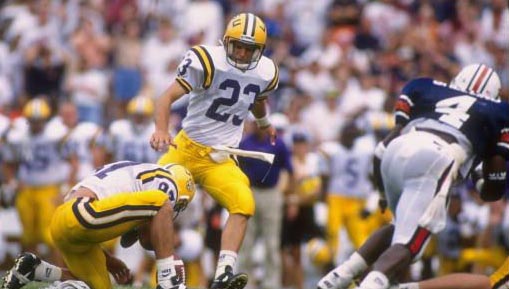
Andre Lefleur (Credit: Rick Stewart/Allsport) |
|
|








































